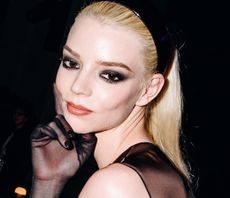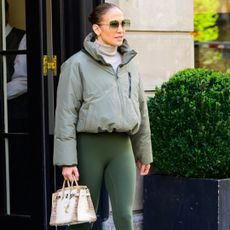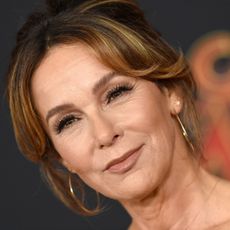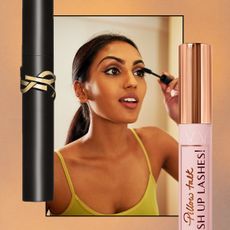For as long as I possibly could, I put off turning 30: I traveled overseas the week of my birthday, dodged my mother's calls on the actual day (er, bad reception?), and then, upon my return, delayed the festivities for a month. I am a natural-born procrastinator — in scheduling haircuts and holidays, even in getting married. And aging, in my mind, was simply no different.
You see, I was granted some pretty good genes and, hence, have always looked young for my age, so serious skincare — not the splash-your-face-with-water-and-fall-into-bed college variety, but the science-scrutinized alpha-, beta-, and omega-infused kind — just never resonated with me. Sure, I've dabbled in a new eye cream here, slathered on an exotic peptide serum there, but my basic regimen has been status quo for the past decade.
But now, since my 30th birthday — and since my discovery of a white eyelash (immediately plucked!), panic about the biological clock, and noticing the permanently etched "11" lines between my eyebrows — it's become apparent that I'm in the thick of it. We live in an era of strategic age management, where 50 looks like 40, and 40 is the new 30. But where does that leave the actual 30-year-olds? Chances are, the prick of a cosmetic needle or scalpel is still foreign to us, but can we afford to hold off for much longer? In another five years, could we still pass for a Gossip Girl's friend, not her mother? Will we still be asked for ID at bars?
In Survival of the Prettiest, author and Harvard psychologist Nancy Etcoff likens physical beauty to athletic skill — it peaks before age 35.
According to Manhattan dermatologist and founder of DDF Skincare, Dr. Howard Sobel, "Thirty is the tipping point of aging. You don't look much different than you did seven years ago, but the next three to five years are critical."
As if that's not depressing enough, MD Skincare's Dr. Dennis Gross puts it like this: "At 30, things are usually not as good as they appear. What lies beneath — cumulative sun damage, crumbling collagen and elastin [the support beams of still-plump skin], and disappearing blood vessels — is about to emerge as brown spots, wrinkles, and sallow and sagging skin if you don't take care of it."
The solutions gross is talking about include the many topical and minimally invasive cosmetic treatments that have been embraced by his 20- and 50-something patients alike. From glycolic peels and nonablative lasers like VBeam and Mixto SX CO2 to injectables such as Restylane, Juvederm, and the ever-popular Botox (despite its recent FDA controversy), in-office choices tallied up to over 9.5 million procedures in 2007 in the U.S.
Stay In The Know
Marie Claire email subscribers get intel on fashion and beauty trends, hot-off-the-press celebrity news, and more. Sign up here.
And it's no wonder women account for 92 percent of that aesthetic tweaking. For us, there's a physiological tug-of-war between youth and beauty. The same delicate skin that allows women to be more characteristically feminine and expressive is the reason that we crease earlier than men, explains Dr. Macrene Alexiades-Armenakas, assistant clinical professor at the Yale School of Medicine. "How that plays out for an individual depends on your genetics" — how dense and resilient your collagen is — "how you've protected your skin from sun and pollution, and your habits with facial expressions."
As I try not to furrow my brow, I recount my past sun sins: tanning in my teens; running, biking, and skiing in my 20s without reapplying SPF. Not horrible, but I decide that I need a more thorough analysis.
At my request, Sobel examines my 30-year-old mug — through his intimidating magnifying glasses, while I sit under a megawatt examination lamp the size of a golf umbrella — and concludes that while I am indeed a young 30, I have a laundry list of "compromised" issues typical of women my age. This includes telangiectasia (aka spider veins) cropping up around my nose; a sprinkling of brown sunspots across the tops of my apples; and deflating cheeks, which are causing slight nasal labial folds to form around my mouth. (And I had always thought of my cheeks as too chubby.) He also offers up Botox right then and there for my developing crow's-feet, "11" lines, and peau d'orange chin. (Apparently, when I purse my bottom lip and crinkle my chin when feeling inquisitive, my skin resembles an orange peel, something I'd never considered . . . until now.) Total bill? About $3750, with touch-ups every four months.
I consider this for about a nanosecond, then realize that not only would I be flat broke, but with my face newly peeled, frozen, and inflated, I'd no longer be able to express my despair. Have we really reached the moment where aging is a complete no-no, to be stalled, or even reversed, at all costs?
Probably sensing my panic, Sobel concedes that there are many less extreme and much less costly over-the-counter options to soften most of my issues — except the one affecting my chin, for which he still suggests Botox. After I politely pass on any needle-based intervention, he sends me away with antioxidants ("the more, the better to help prevent the collagen breakdown"), gentle peels, sunblock, and this insight: "I don't tell anyone they need lasers or injectables, but you have to decide if you're OK with aging."
At home, I try to re-create the stark conditions of Sobel's exam room with 100-watt bulbs and my boyfriend's shaving mirror. Yep, those "11's" are still prominent, and my eyes do crinkle when I smile, but would anyone — besides my dentist — encounter me like this? I think of my skincare-obsessed mother who, enhancement-free at 61, looks reassuringly youthful yet wise — a quality that only comes with age.
Click here for your 10 Step Program for Smart (Needle-Free) Aging
-
 Anya Taylor Joy Is a Gothic Princess in Dior
Anya Taylor Joy Is a Gothic Princess in DiorThe 'Queen's Gambit' actress embraced an all-black dress code at the Brooklyn presentation.
By India Roby Published
-
 Jennifer Lopez Clearly Prefers This Comeback Sneaker Trend
Jennifer Lopez Clearly Prefers This Comeback Sneaker TrendShe's wearing it as often as her favorite Birkin bags.
By Julia Gray Published
-
 Olivia Rodrigo Is Bringing Visible Bra Straps Back
Olivia Rodrigo Is Bringing Visible Bra Straps BackThe pop-punk princess wore custom Victoria's Secret at Coachella.
By Julia Gray Published
-
 Salma Hayek Posted a Makeup-Free Selfie Showing Off Her "White Hairs and Wrinkles"
Salma Hayek Posted a Makeup-Free Selfie Showing Off Her "White Hairs and Wrinkles"She looks stunning.
By Iris Goldsztajn Published
-
 The 20 Best Hair Masks for Damaged Hair, According to Experts and Editors
The 20 Best Hair Masks for Damaged Hair, According to Experts and EditorsHealthy strands, here we come!
By Gabrielle Ulubay Last updated
-
 The 11 Best Magnetic Lashes of 2023
The 11 Best Magnetic Lashes of 2023Go ahead and kiss your messy lash glue goodbye.
By Hana Hong Published
-
 'Dirty Dancing' Star Jennifer Grey Opened Up About Her Hair Thinning
'Dirty Dancing' Star Jennifer Grey Opened Up About Her Hair ThinningAnd how she's adapted.
By Iris Goldsztajn Published
-
 The 12 Best Cream Eyeshadows, According to Makeup Artists
The 12 Best Cream Eyeshadows, According to Makeup ArtistsThe best part? They’re so easy to apply.
By Samantha Holender Published
-
 The Best Mascaras Lift, Lengthen, and Volumize
The Best Mascaras Lift, Lengthen, and VolumizeYour eyelashes will thank you.
By Samantha Holender Last updated
-
 The 9 Best Bronzers for Dark Skin Tones, According to Makeup Pros
The 9 Best Bronzers for Dark Skin Tones, According to Makeup ProsBecause Black and Brown girls like to look tan, too.
By Maya Allen Published
-
 The 15 Best LED Light Therapy Face Masks for At-Home Treatments, According to Beauty Editors and Experts
The 15 Best LED Light Therapy Face Masks for At-Home Treatments, According to Beauty Editors and ExpertsLight up your skincare routine.
By Samantha Holender Last updated